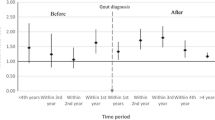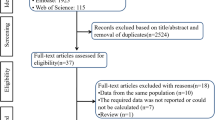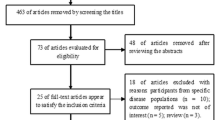Abstract
Previous studies investigating the risk of erectile dysfunction (ED) among patients with gout have produced inconsistent evidence. Therefore, the aim of this meta-analysis was to investigate the relationship between gout and the risk of ED. The Embase, Medline, Scopus, Web of Science and Cochrane Library databases were searched for all studies assessing the risk of ED in patients with gout. Relative risks (RR) and corresponding 95% confidence intervals (CI) were adopted to estimate the association between gout and the risk of ED. Sensitivity analyses were applied to evaluate the robustness of results. Overall, 355,761 participants were included from 8 studies (3 cross-sectional and 5 cohort studies). Of these, 85,067 were patients with gout. Synthesis results showed patients with gout had a 1.2-fold higher risk of ED than individual without gout (RR 1.20, 95% CI 1.10–1.31, P < 0.001). The results of sensitivity analysis are consistent with the trend of synthesis results. The present meta-analysis revealed that the risk of ED in patients with gout was dramatically increased when compared with the general population, which suggests that clinicians should assess erectile function when treating an individual who suffers from gout.



Similar content being viewed by others
References
Kuo CF, Grainge MJ, Mallen C, Zhang W, Doherty M (2015) Rising burden of gout in the UK but continuing suboptimal management: a nationwide population study. Ann Rheum Dis 74(4):661–667. https://doi.org/10.1136/annrheumdis-2013-204463
Zhu Y, Pandya BJ, Choi HK (2011) Prevalence of gout and hyperuricemia in the US general population: the National Health and Nutrition Examination Survey 2007–2008. Arthritis Rheum 63:3136–3141. https://doi.org/10.1002/art.30520
Smith E, Hoy D, Cross M et al (2014) The global burden of gout: estimates from the Global Burden of Disease 2010 study. Ann Rheum Dis 73:1470–1476. https://doi.org/10.1136/annrheumdis-2013-204647
Lee KA, Ryu SR, Park SJ, Kim HR, Lee SH (2018) Assessment of cardiovascular risk profile based on measurement of tophus volume in patients with gout. Clin Rheumatol 37(5):1351–1358. https://doi.org/10.1007/s10067-017-3963-4
Thottam GE, Krasnokutsky S, Pillinger MH (2017) Gout and metabolic syndrome: a tangled web. Curr Rheumatol Rep 19(10):60. https://doi.org/10.1007/s11926-017-0688-y
Lee J, Lee JY, Lee JH et al (2015) Visceral fat obesity is highly associated with primary gout in a metabolically obese but normal weighted population: a case control study. Arthritis Res Ther 24(17):79. https://doi.org/10.1186/s13075-015-0593-6
Roughley MJ, Belcher J, Mallen CD, Roddy E (2015) Gout and risk of chronic kidney disease and nephrolithiasis: meta-analysis of observational studies. Arthritis Res Ther 17:90. https://doi.org/10.1186/s13075-015-0610-9
Tung YC, Lee SS, Tsai WC et al (2016) Association between gout and incident type 2 diabetes mellitus: a retrospective cohort study. Am J Med 129(11):1219.e17–1219.e25. https://doi.org/10.1016/j.amjmed.2016.06.041
Lin S, Zhang H, Ma A (2018) Association of gout and depression: a systematic review and meta-analysis. Int J Geriatr Psychiatry 33(3):441–448. https://doi.org/10.1002/gps.4789
Pushkar’ DIu, Kamalov AA, Al’-Shukri SKh et al (2012) Analysis of the results of epidemiological study on prevalence of erectile dysfunction in the Russian Federation. Urologiia 6:5–9
Hatzichristou D, Kirana PS, Banner L et al (2016) Diagnosing sexual dysfunction in men and women: sexual history taking and the role of symptom scales and questionnaires. J Sex Med 13:1166–1182. https://doi.org/10.1016/j.jsxm.2016.05.017
Chen YF, Lin HH, Lu CC et al (2015) Gout and a subsequent increased risk of erectile dysfunction in men aged 64 and under: a nationwide cohort study in Taiwan. J Rheumatol 42(10):1898–1905. https://doi.org/10.3899/jrheum.141105
Schlesinger N, Radvanski DC, Cheng JQ, Kostis JB (2015) Erectile dysfunction is common among patients with gout. J Rheumatol 42(10):1893–1897. https://doi.org/10.3899/jrheum.141031
Moher D, Liberati A, Tetzlaff J, Altman DG, PRISMA Group (2009) Preferred reporting items for systematic reviews and meta-analyses: the PRISMA statement. PLoS Med 6:e1000097. https://doi.org/10.1371/journal.pmed.1000097
Stang A (2010) Critical evaluation of the Newcastle–Ottawa scale for the assessment of the quality of nonrandomized studies in meta-analyses. Eur J Epidemiol 25:603–605. https://doi.org/10.1007/s10654-010-9491-z
Whiting P, Rutjes AW, Reitsma JB, Bossuyt PM, Kleijnen J (2003) The development of QUADAS: a tool for the quality assessment of studies of diagnostic accuracy included in systematic reviews. BMC Med Res Methodol 3:25. https://doi.org/10.1186/1471-2288-3-25
Higgins JP, Thompson SG (2002) Quantifying heterogeneity in a meta-analysis. Stat Med 21:1539–1558. https://doi.org/10.1002/sim.1186
Begg CB, Mazumdar M (1994) Operating characteristics of a rank correlation test for publication bias. Biometrics 50(4):1088–1101
Egger M, Davey SG, Schneider M, Minder C (1997) Bias in meta-analysis detected by a simple, graphical test. BMJ 315:629–634. https://doi.org/10.1136/bmj.315.7109.629
Hsu C-Y, Lin C-L, Kao C-H (2015) Gout is associated with organic and psychogenic erectile dysfunction. Eur J Intern Med 26(9):691–695. https://doi.org/10.1016/j.ejim.2015.06.001
Kim JH, Chung MK, Kang JY et al (2019) Insulin resistance is an independent predictor of erectile dysfunction in patients with gout. Korean J Intern Med 34(1):202–209. https://doi.org/10.3904/kjim.2016.350
Roddy E, Muller S, Hayward R, Mallen C (2012) Gout, allopurinol and erectile dysfunction: an epidemiological study in a primary care consultation database. Rheumatology (United Kingdom) 51:iii38
Schlesinger N, Lu N, Choi HK (2018) Gout and the risk of incident erectile dysfunction: a body mass index-matched population-based study. J Rheumatol 45(8):1192–1197. https://doi.org/10.3899/jrheum.170444
Abdul Sultan A, Mallen C, Hayward R et al (2017) Gout and subsequent erectile dysfunction: a population-based cohort study from England. Arthritis Res Ther 19(1):123. https://doi.org/10.1186/s13075-017-1322-0
Maynard JW, McAdams MA, Baer AN et al (2010) Erectile dysfunction is associated with gout in the campaign against cancer and heart disease (CLUE II). Arthritis Rheum 62:1544
Fan D, Liu L, Ding N et al (2015) Male sexual dysfunction and ankylosing spondylitis: a systematic review and meta-analysis. J Rheumatol 42(2):252–257. https://doi.org/10.3899/jrheum.140416
Keller JJ, Lin HC (2012) A population-based study on the association between rheumatoid arthritis and erectile dysfunction. Ann Rheum Dis 71(6):1102–1103. https://doi.org/10.1136/annrheumdis-2011-200890
Pluta RM, Shmerling RH, Burke AE, Livingston EH (2012) JAMA patient page. Gout JAMA 308(20):2161. https://doi.org/10.1001/jama.2012.4095
Robinson PC (2018) Gout—an update of aetiology, genetics, co-morbidities and management. Maturitas 118:67–73. https://doi.org/10.1016/j.maturitas.2018.10.012
Salem S, Mehrsai A, Heydari R, Pourmand G (2014) Serum uric acid as a risk predictor for erectile dysfunction. J Sex Med 11:1118–1124. https://doi.org/10.1111/jsm.12495
Long H, Jiang J, Xia J et al (2016) Hyperuricemia is an independent risk factor for erectile dysfunction. J Sex Med 13(7):1056–1062. https://doi.org/10.1016/j.jsxm.2016.04.073
Lue TF (2000) Erectile dysfunction. N Engl J Med 342:1802–1813. https://doi.org/10.1056/nejm200006153422407
Kim YW, Park SY, Kim JY et al (2007) Metformin restores the penile expression of nitric oxide synthase in high-fat-fed obese rats. J Androl 28:555–560. https://doi.org/10.2164/jandrol.106.001602
Abeles AM, Pillinger MH (2019) Gout and cardiovascular disease: crystallized confusion. Curr Opin Rheumatol 31(2):118–124. https://doi.org/10.1097/bor.0000000000000585
Choi HK, Curhan G (2007) Independent impact of gut on mortality and risk for coronary heart disease. Circulation 116(8):894–900
Pan A, Teng GG, Yuan JM, Koh WP (2015) Bidirectional association between self-reported hypertension and gout: the Singapore Chinese Health Study. PLoS One 10(10):e0141749. https://doi.org/10.1371/journal.pone.0141749
Vlachopoulos C, Ioakeimidis N, Terentes-Printzios D, Stefanadis C (2008) The triad: erectile dysfunction–endothelial dysfunction–cardiovascular disease. Curr Pharm Des 14(35):3700–3714
Kostis JB, Jackson G, Rosen R et al (2005) Sexual dysfunction and cardiac risk (the second princeton consensus conference). Am J Cardiol 96(12B):85M–93M. https://doi.org/10.1016/j.amjcard.2005.12.018
Blans MC, Visseren FL, Banga JD et al (2006) Infection induced inflammation is associated with erectile dysfunction in men with diabetes. Eur J Clin Investig 36:497–502. https://doi.org/10.1111/j.1365-2362.2006.01653.x
Vlachopoulos C, Aznaouridis K, Ioakeimidis N et al (2006) Unfavourable endothelial and inflammatory state in erectile dysfunction patients with or without coronary artery disease. Eur Heart J 27:2640–2648. https://doi.org/10.1093/eurheartj/ehl341
Giugliano F, Esposito K, Di Palo C et al (2004) Erectile dysfunction associates with endothelial dysfunction and raised proinflammatory cytokine levels in obese men. J Endocrinol Investig 27:665–669. https://doi.org/10.1007/BF03347500
Vanholder R, Patel S, Hsu CH (1993) Effect of uric acid on plasma levels of 1,25(OH)2D in renal failure. J Am Soc Nephrol 4:1035–1038
Takahashi S, Yamamoto T, Moriwaki Y, Tsutsumi Z, Yamakita J, Higashino K (1998) Decreased serum concentrations of 1,25(OH)2-vitamin D3 in patients with gout. Adv Exp Med Biol 431:57–60
Barassi A, Pezzilli R, Colpi GM, Corsi Romanelli MM, Melzi d’Eril GV (2014) Vitamin D and erectile dysfunction. J Sex Med 11:2792–2800. https://doi.org/10.1111/jsm.12661
Zhu Y, Pandya BJ, Choi HK (2012) Comorbidities of gout and hyperuricemia in the US general population: NHANES 2007–2008. Am J Med 125:679–687. https://doi.org/10.1016/j.amjmed.2011.09.033
Dao HH, Harun-Or-Rashid M, Sakamoto J (2010) Body composition and metabolic syndrome in patients with primary gout in Vietnam. Rheumatology (Oxford) 49:2400–2407. https://doi.org/10.1093/rheumatology/keq274
Besiroglu H, Otunctemur A, Ozbek E (2015) The relationship between metabolic syndrome, its components, and erectile dysfunction: a systematic review and a meta-analysis of observational studies. J Sex Med 12:1309–1318. https://doi.org/10.1111/jsm.12885
Maseroli E, Corona G, Rastrelli G et al (2015) Prevalence of endocrine and metabolic disorders in subjects with erectile dysfunction: a comparative study. J Sex Med 12:956–965. https://doi.org/10.1111/jsm.12832
Liu Q, Zhang Y, Wang J et al (2018) Erectile dysfunction and depression: a systematic review and meta-analysis. J Sex Med 15(8):1073–1082. https://doi.org/10.1016/j.jsxm.2018.05.016
Acknowledgements
This work was supported by the grants from Science and Technology Planning Project of Guangdong Province (No. 2017B030314108).
Author information
Authors and Affiliations
Contributions
Conception or design of the work: ZGZ and LML. Data collection: QX and YHD. Data analysis and interpretation: SKZ, ZGZ and YZL. Drafting the article: LML. Critical revision of the article: ZGZ, JMW. Final approval of the version to be published: ZGZ and LML. All authors approved the final manuscript as submitted and agree to be accountable for all aspects of the work.
Corresponding author
Ethics declarations
Conflict of interest
The authors declare that they have no competing interests.
Additional information
Publisher's Note
Springer Nature remains neutral with regard to jurisdictional claims in published maps and institutional affiliations.
Electronic supplementary material
Below is the link to the electronic supplementary material.
Rights and permissions
About this article
Cite this article
Luo, L., Xiang, Q., Deng, Y. et al. Gout is associated with elevated risk of erectile dysfunction: a systematic review and meta-analysis. Rheumatol Int 39, 1527–1535 (2019). https://doi.org/10.1007/s00296-019-04365-x
Received:
Accepted:
Published:
Issue Date:
DOI: https://doi.org/10.1007/s00296-019-04365-x




